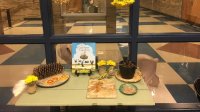Designing Your Pre-K Classroom for Deeper Learning
When working on your classroom layout, it’s important to make sure it helps children feel welcome, inspired, and understood.
Your content has been saved!
Go to My Saved Content.What do you see when you walk into your classroom or other spaces in your school? Look objectively. Look at the walls, the floor, and everywhere in between. The classroom environment, hallways, and more are full of possibilities to show and share children’s work and voices.
In the Reggio Emilia approach, educators say the learning environment is the third teacher (after parents or guardians and the classroom teacher). This means that the learning environment is a crucial space to show wonder, curiosity, ideas, values, pictures, stories, etc., that are being told on a daily basis in the school setting.
As educator Mary Ann Biermeier has written, “The third teacher is the environment—a setting designed to be not only functional but also beautiful and reflective of the child’s learning. It is the child’s relationship with parent, teacher, and environment that ignites learning.”
Learning Can Happen Anywhere
After you see and notice what’s on the walls and how the space is presenting itself, ask how does your space feel? Does it feel cluttered? Does it feel empty? Does it feel reflective of the learners in your school? Does it feel safe? Your goal is not just decorating a beautiful space but also creating a space that fosters wonder, safety, structure, children’s voices, and joy.
Another aspect to consider when thinking about the learning environment as the third teacher is using other spaces that aren’t your classroom. Ideally, your classroom isn’t the only learning space—the hallways, outside spaces, and field trips also help students construct understandings around the questions that you’re wondering about together. There are moments when you can step outside, even for five minutes, and get an answer that ignites deeper learning and understanding compared to looking in a book or tablet.
6 Things to Consider About Your Environment
1. Clear clutter: Children want to be in a space that they can navigate and that has purpose. When working in your room, think about the piles, the baskets, and the toys that aren’t being played with, and remove them or organize them to create a clean and purposeful space.
2. Hang it up: When it comes to what’s on the walls, it’s important to feature the children’s work, their pictures, and stories that involve them because that tells them those things are important enough to be up there and that you want to share their work with others.
3. Inspire wonder and inquiry: How does your space show the values that are important to you and your school? If inquiry is important, make sure your space has some things that cause your students to stop and wonder—maybe a bird's nest if you’re studying habitats, or maybe an X-ray of an animal, or water and shells if you’re studying water.
4. What’s the story? I consider myself a storyteller when communicating our work to others, so I often ask myself, “What story is my environment or documentation telling? How is it inviting children to become inspired and add to, deepen, or change the story?”
For example, one year I did a project on loose parts with my students. On a board in my room, I put the work up as we went along so it showed the process of the project. We placed a web of our thoughts, and a quote from a students when she said that loose parts were everywhere, and then I put pictures of the students creating new things with old loose parts. This “story” gave the students a tangible way to see their work and ideas and to get an idea of the timeline of our project, as well as stay inspired and engaged with it.
5. Offer real experiences: Children want to be taken seriously, and they want opportunities to do real things. What tools do you have out for children to discover meaning and purpose in the world around them? Keeping high-quality materials in the classroom shows that we believe the children will take care of them and use them to answer their questions.
For example, having glass jars filled with different materials (beads, paint, markers, etc.) creates a message that you believe children can take care of fragile items. You are communicating that you trust them and believe in them.
6. Make sure all children are seen: How will all of your students feel seen and valued in your space? It’s not about having 18 cat crafts hanging up on the wall, but rather the story being told about the experiences you have had together as a class. You might have pictures of some students, quotes from others, and work of others—together all that tells students why and how you are deepening the learning. Make sure each student is being seen in some way so they feel valued and inspired.
Children spend a lot of time in school, so it’s important for them to be in a space that’s inviting and welcoming, and that says, “I see you.” You can create a space that excites them and changes based on their interests and current thinking. The room is also a space for you as well, so think about what kind of space you and your colleagues want to work in. Reflect on your and your students’ story—what do you want to share and why do you want to share it?
In the end, this work is about sharing children’s voices and empowering them so that they see themselves as important, heard, capable, competent, and creative.
